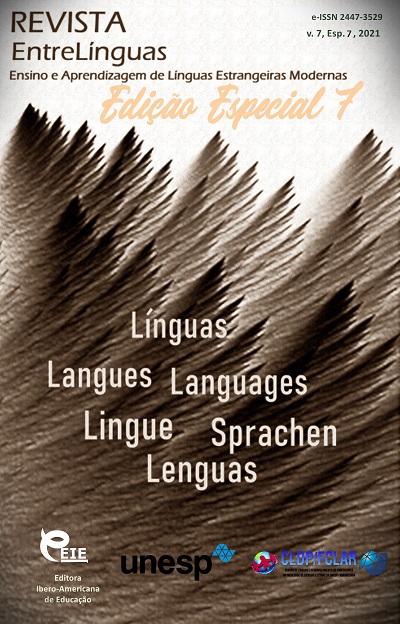Tolerant language personality as the basis of communicative interaction
DOI:
https://doi.org/10.29051/el.v7iesp.7.16338Keywords:
Social communication, Tolerance, Metaphor, Slang, Language personality, Experiment, Intolerant behavior, Social archetypesAbstract
The article presents some results of an experimental study of the formation of a tolerant language personality. The authors describe the levels of tolerance, their representation in academic and naive everyday communication. The article substantiates a comprehensive approach to the study of the phenomenon of tolerance, which allows us to reveal the role of cultural stereotyping in the development of a communicative situation. Since culture sets a certain system of values and assessments that have a semiotic nature, social constants cannot but influence the creation of a common landscape of communication and a single figurative series of statements. In this regard, the authors note the high potential of tropes that promote positive communication and function in the lexicon of a tolerant language personality.
Downloads
References
BOYKO, V.V. (2008). Psychoenergetics. Saint Petersburg: Piter, 416 p.
ZUBKOVA, O.S. (2010). Medical metaphor-term as mental representation. Questions of cognitive linguistics. Scientific and theoretical journal, 3, 41-48.
ZUBKOVA, O.S., Fakhrutdinova A.V., Grigorieva L.L. (2020). Experimental study of the formation of students ' tolerance in the process of learning a foreign language. Scientific notes. Electronic scientific journal of Kursk state University, 1(53), 134-143.
LEONTIEV, D.A. (2009). Towards the operationalization of the concept of tolerance. Question of psychology, 5, 3-16.
CASADEI, F. (1995). Per una definizione di ‘espressione idiomatica’ e una tipologia dell’idiomatico in italiano. Lingua e stile, 30(2), 335-358.
GRIGORIEVA, L., FAKHRUTDINOVA, A., ZUBKOVA, O. (2019). Reflection of religious worldviews in arabic, english, and russian phraseology. Journal of Sociology and Social Anthropology, 10(4), 203-208.
SOBOLEVA, N.P., FAKHRUTDINOVA, A.V., ZUBKOVA, O.S. (2019). Linguosemiotic correlation of categorial domains of professional metaphor in individual signification practice. Journal of Research in Applied Linguistics, 10, 341-349.
VINZERICH, A. (2007). La sémantique du possible : approche linguistique, logique et traitement informatique dans les textes. Thèse de doctorat. Université de Paris-Sorbonne, 398 p.
TAKHTAROVA, S.S., ABUZYAROVA, D.L., KHAIRUTDINOV, R.R., MOROSOVA, O. (2019). Politeness in the German Ethnosocium: The Diachronic Aspect. Academic Journal of Interdisciplinary Studies, 8(2), 46-50.
FAYZULLINA, O.R. (2019) Ways of international students' adaptation: Club of international friendship. Space and Culture, India, 6(5), 87-98.
Downloads
Published
How to Cite
Issue
Section
License

This work is licensed under a Creative Commons Attribution-NonCommercial-ShareAlike 4.0 International License.
Os manuscritos aceitos e publicados são de propriedade da Revista EntreLínguas. Os artigos publicados e as referências citadas na Revista EntreLínguas são de inteira responsabilidade de seus autores.
Transferência de direitos autorais – autorização para publicação
Caso o artigo submetido seja aprovado para publicação, já fica acordado que o(s) autor(es) autoriza(m) a UNESP a reproduzi-lo e publicá-lo na EntreLínguas, entendendo-se os termos “reprodução” e “publicação” conforme definição respectivamente dos incisos VI e I do artigo 5° da Lei 9610/98. O artigo poderá ser acessado pela rede mundial de computadores (Internet), sendo permitidas, a título gratuito, a consulta e a reprodução de exemplar do artigo para uso próprio de quem a consulta, desde que haja a citação ao texto consultado. Essa autorização de publicação 328 EntreLínguas, Araraquara, v. 1, n .2, p. 323-328, jul./dez. 2015 não tem limitação de tempo, ficando a UNESP responsável pela manutenção da identificação do(s) autor(es) do artigo. Os artigos publicados e as referências citadas na Revista EntreLínguas são de inteira responsabilidade de seus autores.











